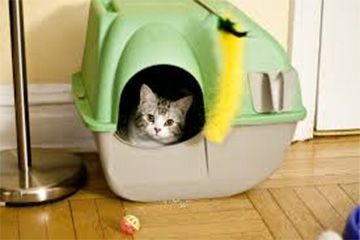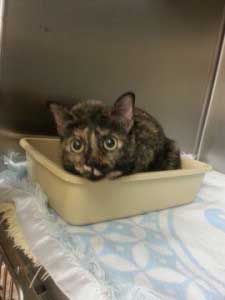
My cat is straining in the box….again!
Feline idiopathic cystitis, also known as feline lower urinary tract disease are both terms that describe the following symptoms:
- Bloody urine
- Straining to urinate (can easily be mistaken for straining to defecate)
- Urinating in unusual places
- Urinary blockage (almost exclusively a male cat problem and constitutes an emergency)
- Licking the urinary opening (usually due to pain).
So how do we sort out the causes of these symptoms?
- 50% will not have a cause that can be identified despite extensive testing.
- 20% will have bladder stones.
- 20% will have a urethral blockage.
- 1-5% will have a true infection.
- 1-5% will have a urinary tract cancer.
- 1-5% will have had trauma to the urinary tract (i.e., have been hit by a car etc.)
- 1-5% will have a combination of a bladder stone and an infection.
What this tells us is that the majority of adult cats with the above symptoms have bladder inflammation with an unknown cause, also know as Feline Idiopathic Cystitis.
Here are some things we know about this condition:
- Lower urinary tract signs tend to recur. Most cats with this condition will have flare ups after the first onset of symptoms.
- There seems to be an association with environmental stress.
- This condition seems to be targeted towards younger adult cats, and flare up’s decrease as the cat gets older.
- As difficult as it is to address a flare up in progress, more success has been achieved in preventing future episodes.
Prevention of Future Episodes
- Feeding primarily canned food/Increasing water consumption
- Environmental enrichment
- Relieving environmental stress
Increased water consumption
By increasing the amount of water consumed by the cat, the bladder is more distended and the urine is more diluted. Canned cat food is 80% water so simply switching to canned foods will increase a cat’s water consumption. Also, filling the water bowl while the cat is watching or getting a drinking fountain encourages the cat to take a drink. Canned cat food is vital to your cat’s overall health, visit this great website for more info on switching your cat to canned cat food and why that is so important…catinfo.org
Environmental enrichment
One might think a cat has plenty of toys and seems relaxed and well-adjusted but the reality is that the cat’s natural environment of living in the forest and hunting and eating mice regularly throughout the day is a far cry from sitting on a sofa, eating processed foods, and eliminating waste in a plastic box filled with clay. Most cats are fine with the domestic lifestyle but the FIC cat is special and has special sensitivity. Stress can be minimized by allowing choices for the cat in terms of where to play, rest, eat, and eliminate.
Here is a summary of recommendations that have been published:
- Each cat at home should have the opportunity to play with the owner or with another cat if he chooses to.
- Each cat should be able to move freely about her home including climbing if she chooses to.
- Each cat should have convenient access to a private rest area where other animals will not disturb him or an escape route should he be bothered. There should be no loud appliances in the rest area that might suddenly come on and be frightening.
- Scratching posts should be available.
- Toys should be regularly rotated and replaced. Each cat should be able to choose warmer and cooler areas within the home.
- There should be a litter box for each cat, ideally plus one extra. Litter boxes should be located in well-ventilated areas and should be kept clean. Boxes should be washed out weekly with a minimally scented detergent. Unscented clumping litter seems to be best. If there is more than one floor in the home, there should be a box on each floor. Litter boxes should be private enough that other animals will not be bothering the cat and loud appliances will not startle the cat during litter box use.
- Each cat should have her own food and water bowls. Feeding/watering stations should be safe so that other animals (like dogs) will not be startling the cat.
Our clinic cat, Sassy is a great example of a cat with idiopathic cystitis. Sassy showed symptoms of straining to urinate, urinating outside her litter box, and had blood in her urine. Her urinalysis and urine cultures showed no infection present and no bladder tumors or stones were seen on her ultrasound. She was started on a canned food only diet but she continued to have cystitis flare ups. Her condition was so severe we took surgical biopsies of her bladder to find out what was going on. Her biopsies came back as inflammation and she was started on an oral steroid and Dasequin. In spite of everything we tried to help her she continued to have problems. After consulting with Dr. Buffington, the founder of The Indoor Cat Initiative (www.indoorpet.osu.edu) we started focusing on making her life as stress free as possible. We increased her toys and play with her more often, we allowed her to choose the cat litter and litter box she liked the best, and provided her with a heated bed, allowing her to choose if she wants to sleep in warmth or in her soft regular bed.


Ellie came to us for an exam because she was urinating frequently in her litter box, but only produced small amount of urine. She was vocal and just acting unusual. We submitted her urine sample to culture for bacteria and it came back negative. With a urinary tract infection ruled out we recommended increasing her water intake with a drinking fountain and starting on canned food. Days later her owner reported Ellie is back to normal and doing great!
Many people are surprised to find that environmental enrichment has been effective in prevention since it does not involve medication or diets but it is important to remember that what makes a cat vulnerable to this condition is that they are sensitive to stress and it is triggering the cystitis.







